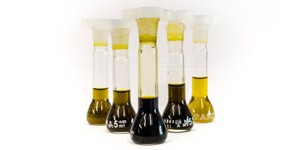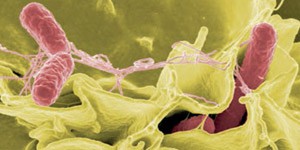By Michiel Panhuysen

Michiel Panhuysen is a Dutch journalist. Since many years he writes articles in Highlife, a Dutch lifestyle magazine. He published two books about the Dutch cannabis world, together with Nicole Maalsté: 'Polderwiet' (2007), with portraits of Dutch hemp growers, and 'De Wietindustrie' (2015), a description of the hemp economy in The Netherlands.
His articles about organic gardening are published in several magazines in different countries. He is author of 'Le Bio Grow Book', published in France (2016).
Besides articles about organic growing issues and cannabis related issues Panhuysen is publishing about running ultramarathons in the mountains. He wrote several books on demand about different subjects.
(This article is based on a synopsis of the article 'Determination of pesticide residues in Cannabis Smoke' written by Nicholas Sullivan, Sytze Elzinga and Jeffrey C. Raber, The Werc Shop Inc., Pasadena USA, published in Journal of Toxology, Volume 2013)
In the United States many states legally allow dispensaries to sell cannabis to be used as a medicine. Unlike other crops that are used for human consumption, there's no control on the pesticides used on cannabis plants. The study 'Determination of pesticide residues in Cannabis Smoke' shows that many patients who use cannabis are exposed to toxic pesticides.
People who use medicinal cannabis are vulnerable because they are ill. Any medicine they take should improve their health, and not harm them. Medicinal cannabis is allowed in many states and countries, but most people do not realize that the consumption of it might cause health problems, because of the contamination with pesticides or other harmful chemicals.
The US Environmental Protection Agency (US EPA) determines what pesticide levels on food crops are allowed. The Federal Department of Agriculture (FDA) and de US Department of Agriculture (USDA) take care of the control of crops. FDA and USDA are monitoring crops for human consumption to guarantee that only allowed pesticides are used and that maximum allowed levels of pesticides on crops or food are not exceeded.
Tobacco is not a food crop. US EPA allows 37 different pesticides on tobacco, but there are no limits on the maximum quantity of pesticides on tobacco. Some laboratories have determined what quantities of the tolerated pesticides may be used to moderate the level of pesticide exposure of the public.
For cannabis plants, the US EPA did not yet approve any pesticide, because cannabis is a federally illegal substance. Without the approval of the US EPA, the use of pesticides on cannabis plants is illegal. This does not impede that pesticides are used on cannabis crops. Cannabis growers can easily buy all kind of pesticides, growth stimulators and nutrients in shops and online. Some of these products are only approved for the use on plants which are not for human consumption like ornamental plants or flowers.
Despite of the illegal status of the pesticides, testing laboratories and authority laboratories often find pesticide residues on cannabis samples. In 2009, a laboratory in Los Angeles tested three medical cannabis samples. In one of the samples they found 1600 times the legal quantity allowed in food for a pesticide called bifenthrin
Toxic
There's no control on the use of pesticides on cannabis crops. Most pesticides are toxical for humans. The toxical effects of the pesticides in cannabis can cause extra health problems for patients with immunological problems or diseases of the liver. But there's been done only little research on this matter. Research could reveal what pesticides in what quantities are acceptable on cannabis crops. For recreational use, but even more important, for medicinal use.
Smoking is the most preferred way to use cannabis. Heating pesticides can change their composition. When some pesticides like myclobutanil are heated, they decompose in very dangerous toxics. Therefore, myclobutanil is recently (2017) banned in Canada, Colorado, Washington, and Oregon for the production of marijuana. But other states in the US that allow medical marijuana still tolerate this pesticide. At this moment the knowledge about the effects of pesticides on humans is very limited. The same applies to the different effects between vaporizing (200 degrees Celsius) or burning (400 degrees Celsius) contaminated cannabis. It's conceivable that vaporizing pesticides produces other toxic releases than burning.
Because of this lack of information it's important to do research on the consequences of the exposure to cannabis contaminated with pesticides. The new information can be used for regulations of pesticides for the cultivation of cannabis.
Filters
Tobacco smokers often use cigarettes with cotton filters. These filters absorb a big part of the pesticides. Cannabis smokers mostly do not use cotton filters in marijuana cigarettes or smoking devices. Therefore they probably inhale relatively more pesticides than tobacco smokers.
In 2013 a study on the absorption of pesticides of three smoking devices used by cannabis smokers is done by The Werc Shop in Pasadena (California), a cannabis and botanical testing laboratory. The three smoking devices were: a small glass pipe, a waterpipe and an identical waterpipe with activated carbon and cotton filters. The pesticides that were tested were: bifenthrin, diazinon and permethrin. Also a growth regulator called paclobutrazol was tested. The goal of the study was to test how much of the pesticides and growth regulator passed through the three different smoking devices.
The test was done by contaminating clean cannabis with the chemical products. The cannabis was 'inhaled' by a machine through the three different smoking devices. After that, the 'inhaled' smoke was examined.
Results
The results of the study were obvious. Residues of pesticides and growth regulators on cannabis were directly transferred into the smoke inhaled by the machine. When the glass pipe was used, about 60 to 70 percent of the chemicals on the cannabis were recovered in the inhaled smoke. This means 60 to 70 percent of the pesticides on the cannabis crops was inhaled and only 30 to 40 percent of the pesticides was filtered (or disappeared as side smoke).
For the regular waterpipe the recovery was about 40 to 60 percent. This means that about half of the pesticides on the cannabis was inhaled by the machine and the other half was filtered. The waterpipe with an extra cotton filter rated best. The recovery was only slight above zero to ten percent. So the machine finally only inhaled maximum ten percent of the pesticides on the cannabis and 90 percent or more was filtered. In the carbon filters no significant residues were found.
Conclusions
In normal life situations the machine in the test is the human who is inhaling smoke. This means an alarmingly high quantity of the pesticides is still in the smoke inhaled by the cannabis user. How much pesticides are inhaled depends on the device that is used. The waterpipe plus extra cotton filter guarantees the best filtering, but few users use filtered smoking devices.
Considering these results, someone who smokes cannabis is probably exposed to a big quantity of pesticides. For patients using cannabis this can lead to further health complications. The researchers state that it's possible that negative consequences of long-term cannabis use, that are found in some other studies, are possibly not caused by the cannabis, but by the pesticides on the crops. This studies may have tested the use of long-term pesticide contaminated cannabis, without being aware of it.
Another important note from the researchers is that the quantity of pesticides that are consumed by a user also depend on the depth of breath, the length of inhalation hold time and the choice of the heating method. All these factors influence the quantity of pesticides that finally are absorbed by the lungs.
Pesticides in medicinal cannabis may cause additional health complications to patients. Filtering the smoke can reduce the amount of pesticides. But it is better to assure pesticides are not present on the cannabis crops in the first place. Therefore regulations like the ban on myclobutanil in Canada and some states in the US is necessary. Furthermore research is needed on the use of pesticides on cannabis crops and the effects of different ways to consume medicinal cannabis.
This study was done to bring attention to the importance of pesticide awareness and to bring regulations on pesticides on cannabis crops closer.


